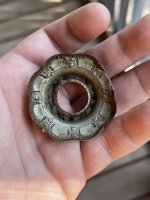dump_digger
Jr. Member
So i've remembered why I haven't done this before now and it's because I find it completely overwhelming but I am determined to actually get it done this time. To me, some of the Akro Agate and Peltiers are hard to distinguish. Like the Akro corkscrew Prize name look a lot like some of peltier Peerles patch, which in turn look like the Marble King Rainbows. Is there a secret? Some identiifying characteristic that sticks out? All the slags and swirls seem to look the same. I've decided to just all the slags together, and the swirls, etc then try and narrow it down from there. I do have some that I am completely lost on though that i'll post some pictures of. One last question--how can you determine if it's oxblood?





